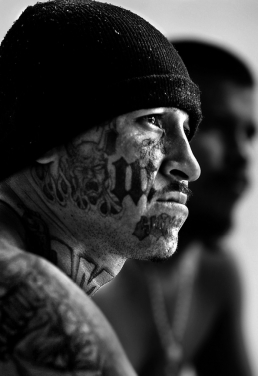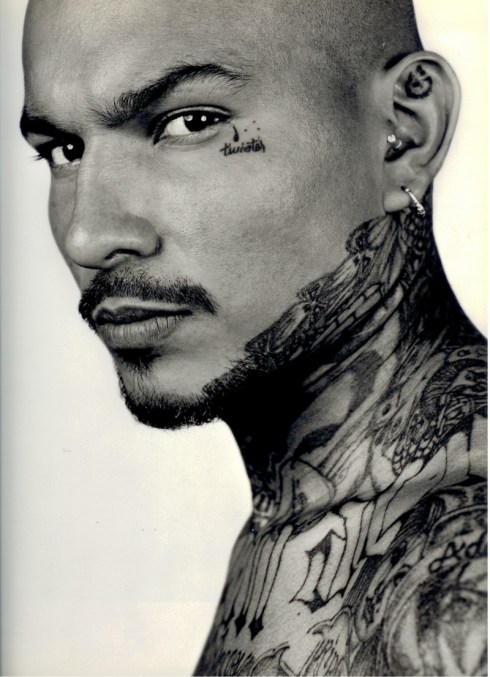Last week, when Foto8 ran Katarzyna Mirczak‘s article about of the detached and preserved skin of prisoners’ tattoos, I was, of course, compelled to post about it. But, in truth, I need to do a lot more than duly note a story published elsewhere.

HOW HAVE PHOTOGRAPHERS TAKEN ON THE SUBJECT OF PRISON TATTOOING?
The simple answer is with limitations. Photography can describe tattoos very precisely, but description is not comprehension. Often, prison tattoos are a tactically guarded language.
Even if tattoo symbols are deciphered, they may carry different meanings in other cultures. Prison systems exist across the globe, within and “outside” different political regimes, thus the tattoos of each prison culture should be considered according to their own rules – and this caveat applies even at local levels.
Janine Jannsen offers a good introduction to the history of different tattooing cultures. She summarises tattooing in “total institutions” (navy, army, the penitentiary); tattoos and gender; and tattoos and the demarcation of space.
With regards to prison tattoos, maybe it helps us to think of photography as secondary to sociological research. Photography should be thought of as an illustrative tool to aid external inquiry.
That said, there are a number of photographers who have made honorable efforts to describe for a wider audience much of the significance of prison and gang tattoo cultures.
Araminta de Clermont
After their release from prison, Araminta de Clermont tracked down South African gang members and discovered their stories. Interview with Araminta and her subjects here.

© Araminta de Clermont
Donald Weber
Donald Weber mixed with former prisoners (‘zeks’) in Russia and concentrated on how their prison tattoos relate to their identity and criminal lifestyle. The relationships of these men with female criminals and prostituted women (‘Natashas’) who become their companions feature in Weber’s complex investigation.
“Some rules are simple: you can only get a tattoo while in prison.”

September 1, 2007: Vova, zek. The origins of Russia’s criminal caste lie deep in Russia’s history. Huge territories of Russia were inhabited by prisoners and prison guards. Thieves, or zeks, distinguish themselves from others by tattoos marking their rank in the criminal world: there are different tattoos for homosexuals, thieves, rapists and murderers. © Donald Weber / VII Network.
Rodrigo Abd
Rodrigo Abd‘s portraits of Mara gang members in Chimaltenango prison in Guatemala illustrate gang tattoos that are used less and less (from 2007 onwards) due to the unavoidable affiliation and violence they brought the bearer; “After anti-gang laws were approved in Honduras and El Salvador, and a string of killings in Guatemala that were committed by angry neighbors and security forces, gang members have stopped tattooing themselves and have resorted to more subtle, low profile ways of identifying themselves as members of those criminal organizations. Today, gang members with tattooed faces, are either dead, in prison or hiding.”

© Rodrigo Abd / AP
Luis Sinco
In 2005, Luis Sinco of the Los Angeles Times documented Ciudad Barrios Penitentiary in El Salvador, home to 900 gang members, many of whom have been deported from the US. Ciudad Barrios incarcerates only members of the MS-13 gang, which traces its roots to the immigrant neighborhoods west of downtown L.A.
“In the woodshop, inmates made a variety of home furnishings, most of which featured the MS-13 logo. The items sold outside the walls help supplement the prisoners’ meager food rations.”
“It was a of microcosm of L.A.’s worst nightmare transplanted. Claustrophobic, crowded tiers led to darkened, bed-less holding cells and fetid latrines overflowing with human waste.”
Multimedia here.

Moises Saman
In 2007, Moises Saman documented the anti-gang activities of Salvadorian Special Police and the inside of Chalatenango prison, El Salvador. At times Saman’s project focused on the tattoos but is more generally a traditional documentary project. More here and here.

© Moises Saman
Isabel Munoz
Much of Isabel Munoz‘s portraiture deals with markings of the body – what they reveal and conceal. For example, she has previously photographed Ethiopian women and their scarification markings. For her project Maras, Munoz shot sixty portraits in a Salvadorian prison of ex-gang-members. She also photographed the women in these mens’ lives. More here and here.

© Isabel Munoz
Christian Poveda
In El Salvador, Christian Poveda photographed and filmed Mara Salvatrucha (known as MS) and M18, the two Las Maras gangs in open conflict. Poveda wanted to describe their mutual violence and the absence of ideological or religious differences to explain their fight to the death. He described the origins of their war as “lost in the Hispanic barrios of Los Angeles” and as “an indirect effect of globalisation.”
Poveda was shot dead aged 52 as a direct consequence of his journalism. His work from El Salvador was entitled La Vida Loca. Full gallery can be seen here. B-Roll from his work can be seen here.

© Christian Poveda
More Resources
Ann T. Hathaway has collated (disturbing) information and links here about a number of prison tattoo codes.
Russian criminal tattoos have warranted their own encyclopaedia.

8 comments
Comments feed for this article
July 18, 2010 at 5:56 pm
Ann T. Hathaway
Dear Mr. Brook,
Thanks for mentioning my blog here and the post. I am very impressed with this post and its beautiful photographs. I also love that you have credited everyone, something that most are not inclined to do.
I will be linking here–a cross-link! I suppose, and also be reading through your blog further.
Sincerely,
Ann T. Hathaway
July 18, 2010 at 6:04 pm
petebrook
Ann. You’re welcome, and thank you very much. If you want to know about how I think of this blog please read this: http://www.positive-magazine.com/reportage/prison-photography/
July 24, 2010 at 7:30 pm
Kim
Great compilation. Having been to Central America a few times, I was struck by how much the fear of the Maras is palpable there, especially (I found) in El Salvador. It’s a luxury to get to sit here and examine the artistic side of the social statements. Worth understanding though!
August 3, 2010 at 3:04 pm
marco
amazing how years after S@#$ really hit the fan about gangs in C.A. in the 90s the phenomena has evolutioned into a documentarists artistic endeavor.
November 5, 2010 at 11:40 am
Sergei Vasiliev’s Photographs in the Russian Criminal Tattoo Encyclopaedia « Prison Photography
[…] posted before about prison tattoos: Prison Tattoos and the Photographers’ Intrigue Klaus Pichler: Central European Prison Tattoos, Taxidermy and Beguiling Portraits of Odessans […]
November 20, 2010 at 11:33 am
Herbert Hoffman’s Tattoos AND Photography « Prison Photography
[…] my posts on prison tattoo photography have been very popular – [1], [2], [3], and [4]. Continuing the theme, I’d like to feature the work of Herbert […]
February 25, 2011 at 2:01 am
On Prison Tattoos | The Reference Council
[…] Read it here. […]
May 15, 2012 at 1:11 pm
ENCARCELACION: The Global Post Looks at “Latin America’s Fatal Prison Problem” « Prison Photography
[…] Vance Jacobs and Columbian prisoners – tourist photography in Bolivian prisons – prison tattoos (some from Central America) – Kate Orlinksky’s portraits of Mexican female prisoners – Fabio Cuttica at a Columbian […]